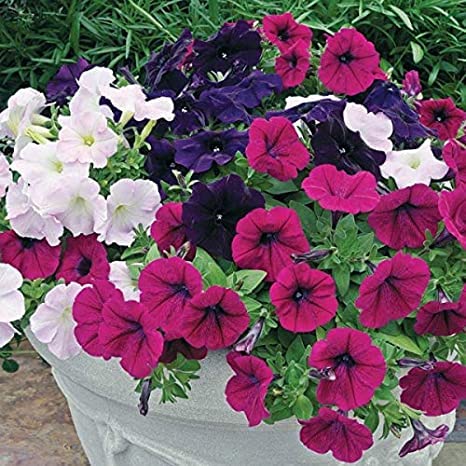Mixed Color Petunia Flower Seeds for Home & Garden
Couldn't load pickup availability
Description
Mixed Petunia Seeds (Rare Colors)
Welcome to bijaseeds, a big, trusted name in the USA seed market with a vast, high-quality selection of non-GMO seeds and heirloom seeds. Our Mixed Petunia Seeds in rare colors offer gardeners of all skill levels the opportunity to cultivate breathtaking blooms in unique shades—think deep purples, soft corals, and striking bicolors. Discover how these flower seeds can transform your garden with the guidance below.
Characteristics and Uses of Mixed Petunia Plants
Petunias are beloved for their trumpet-shaped flowers and lush, cascading growth, typically reaching 6–18 inches in height and spreading up to 2–3 feet. This rare colors mix introduces extraordinary hues not often found in standard varieties, making them a standout choice for containers, hanging baskets, or garden beds. Beyond their visual appeal, petunias attract pollinators like bees and butterflies, enhancing biodiversity, and their blooms are perfect for cutting to create vibrant indoor arrangements. These seeds for planting promise both beauty and functionality for any gardener.
Growing Conditions for Mixed Petunia Plants
- Light Requirements: Full sun is best—aim for at least 6 hours of direct sunlight daily.
- Temperature: They thrive in warm conditions, ideally 60–75°F (16–24°C).
- Soil Preferences: Well-draining, fertile soil with a slightly acidic pH (6.0–6.8) works wonders.
- Humidity: Moderate levels are ideal; they tolerate dry air but dislike excessive moisture.
Planting Tips for Mixed Petunia
- Timing: Start seeds indoors 8–weeks before the last frost or sow directly outdoors after frost danger passes.
- Depth: Barely cover seeds with soil—they need light to germinate—or press lightly into the surface.
- Spacing: Plant seeds 1–2 inches apart, thinning to 8–12 inches as seedlings develop.
- Germination: Expect sprouts in 7–1days with warmth and consistent moisture.
Watering Instructions and Tips
- Frequency: Water when the top inch of soil dries out—about once or twice weekly, depending on climate.
- Amount: Soak the soil evenly, ensuring excess drains away to avoid root rot.
- Tips: Water at the base rather than overhead to keep foliage dry and healthy.
Growing Zones
- USDA Zones: Grown as annuals in zones 2–8 or perennials in zones 9– with mild winters.
- Global Zones: Thrive in temperate to subtropical climates; protect from frost in cooler regions.
Key Benefits & Uses
- Uniqueness: Rare color varieties add an exclusive touch to your garden.
- Pollinator-Friendly: Supports local ecosystems by drawing in beneficial insects.
- Versatility: Perfect for sustainable designs in pots, borders, or as ground cover.
Best Uses in the Garden & Landscape
- Containers: Shine in pots or window boxes, showcasing their cascading blooms.
- Hanging Baskets: Ideal for spilling over edges with vibrant, rare hues.
- Garden Beds: Use as edging or fillers to create a colorful landscape accent.
Conclusion
Our Mixed Petunia Seeds in rare colors are a delightful addition for gardeners eager to grow something truly special. With bijaseeds, a big, trusted name in the seed world, offering a wide range of high-quality, non-GMO varieties to gardeners everywhere, you’re set to enjoy these eye-catching blooms with ease. Plant today and watch your garden come alive with uncommon beauty.
FAQ
How do I grow Mixed Petunia seeds?
Sow seeds lightly on the soil surface indoors 8–weeks before the last frost, keeping them warm and moist. They’ll sprout in 7–1days with ample light, ready to transplant once they’re sturdy.
When should I plant Mixed Petunia seeds?
Start indoors in late winter or early spring, or sow directly outside after the last frost for summer-long blooms.
Are Mixed Petunia seeds hard to grow?
No—they’re quite manageable! With basic care like sun, well-drained soil, and regular watering, even beginners can succeed.







